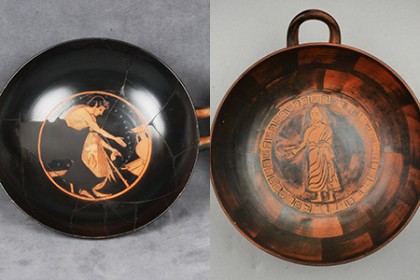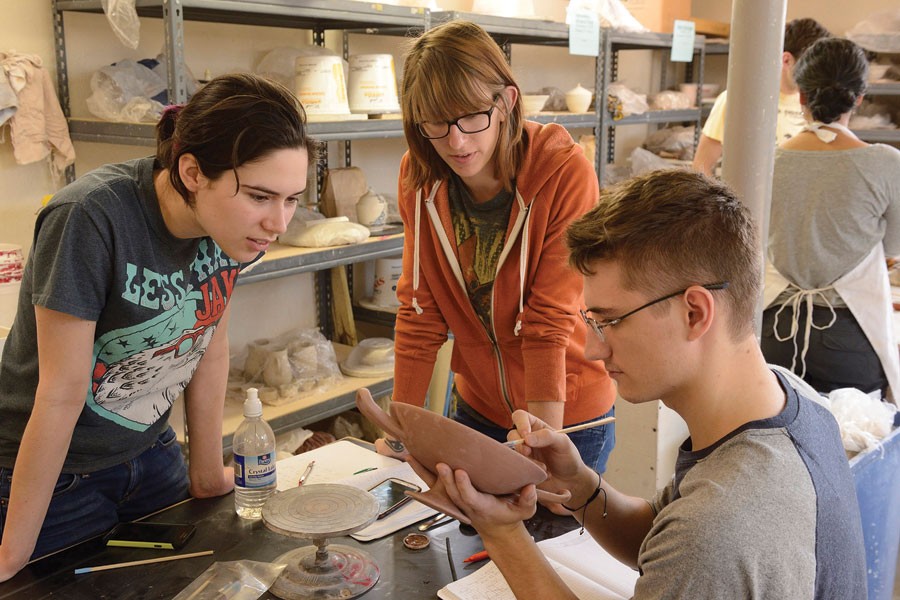Thirteen Johns Hopkins undergraduates divide themselves into four groups and huddle over tables at Baltimore Clayworks, the ceramic arts studio in Mount Washington. Every group is trying to paint lines on clay tiles; each student has a specific task. Some paint. Some write down what kinds of marks are being made. And some take photos of the process.

Image caption: Left: The ancient version (JHUAM B4) is a cup by the Phintias Painter, dated to 510 BCE, from ancient Greece Right: The new version (“2015cup”) was potted by ceramic artists from Baltimore Clayworks Matthew Hyleck and Cami Ascher, and painted by JHU undergraduates Hana Chop, Savannah De Montesquiou, and Arthur Zhang
This course in the Krieger School of Arts and Sciences isn't a simple pottery class. For one, a documentary crew led by filmmaker Bernadette Wegenstein, a research professor in the Department of German and Romance Languages and Literatures, shadows the students as they work. For another, instead of using a commercial slip—the suspension of water and clay used as paint—the groups are using one handmade by Matthew Hyleck, a Clayworks ceramic artist, and their class instructor, Sanchita Balachandran. And the students are painting with individual animal hairs.
"I have horse hairs, hog hairs, and cat whiskers," Balachandran tells the class. "See what kinds of lines you can get with one hair versus a bundle of three."
Balachandran, the Johns Hopkins Archaeological Museum's curator/conservator, designed this course as an intensive, interdisciplinary research project in experiential archaeology. She's trained to figure out how things were made, and she's particularly interested in ancient technology. The museum has a collection of Attic red-figure vases that date from ca. 520–470 BCE, and a few are renowned for images created on them by famous painters. How did the ancients get such incredibly precise and shiny red figures and raised black lines on these two-handled drinking cups called kylixes?
A number of theories have been proposed. Classical art historian Joseph V. Noble's book The Techniques of Painted Attic Pottery, published in 1965, includes a two-page précis on pottery techniques that has become the prevailing theory for classical scholars; Noble, however, never threw a pot himself. Toby Schreiber, a potter, studied the Getty Museum's ancient pottery collection and proposed her own theory with Athenian Vase Construction: A Potter's Analysis (1999). And in the 1920s, Gisela Richter, a Metropolitan Museum of Art curator of Greek and Roman art, took ceramics classes to write *The Craft of Athenian Pottery *(1923).
Each author's pottery-making theory is shaped by his or her professional perspective. So when Elizabeth Rodini, the director of the Krieger School's Program in Museums and Society (which is supporting the class along with a grant from the Andrew W. Mellon Foundation), asked Balachandran what her dream course to teach would be, the conservator knew exactly what to try. "I want to know how these objects were made," Balachandran says. "I want it to bring together all these different specialists who have something to say about these technologies to talk to each other and to us."
Over the semester's 12 weeks, the students in Re-creating Ancient Greek Ceramics are immersed in three rigorous disciplines. Through readings and class speakers, and in subjects from art history to classics, to conservation, to materials science and engineering, they're navigating the cultural history and techniques of Greek pottery. They're immersed in social science research techniques as they document, in journals and on the class's blog, the various scholarly ideas they're testing out in the Clayworks studio. And they're recording everything obsessively because Balachandran and Hyleck are having them, given the published information available, try to replicate the clay, slip, kiln, and firing techniques of the ancient Greek era.
During the university's winter break Hyleck and Balachandran built a kiln from scratch, starting with wet materials, mixing those together to make clay, shaping that clay to form bricks, and using those bricks to construct a beehive-style kiln. This raw materials–to–end product approach puts a number of theories into practice with an unknowable outcome, and there are no guarantees that any of it is going to produce the desired results: black marks on red clay.
Hyleck says the project's ambition was initially a bit overwhelming, when Balachandran called him about it last year. At that time, he points out, he knew nothing about Greek Attic ware, and he didn't work with the same materials (earthenware) or techniques (firing at low temperatures). But the vases themselves, those interested him. And when he and Balachandran met up at the museum to discuss the class, she asked if he wanted to handle one of the vases. "Absolutely I want to hold that," Hyleck says, referring to a kylix attributed to Phintias as painter. "It's every potter's dream to be able to hold those things."
In doing so, a potter today could admire the work of one 2,500 years ago. "At this point I can look at something and pretty quickly start to hypothesize how it would be done," Hyleck says. "And picking up and holding one of these pieces—when you look through a glass vitrine at a museum, all objects have visual weight that we as humans infer—and these are so remarkably light compared to what I inferred. When you pick these up, they just float."
Handling the vase, Hyleck could understand how the potter distributed its weight. "That control starts to tell you a lot about craftsmanship," he says. "Those are things that I wish there was a way to convey to everyone, but tactile is the only way to translate that."
That sense of intimacy, of transforming information to a human scale, is one of the experiences Balachandran hopes her students are gaining from the class. "These have become aesthetic objects, like paintings that happen to be on vases," she says. "But anytime I've given people a chance to work with the material, it's a very humbling experience. It forces you to look at [the vases] in a much more thoughtful way. And to me that's the whole point of art—it's storytelling, it's about recognizing the human genius in an object."
Each group is decorating a kylix, under the guidance of Hyleck, and each student is making a tile. Hyleck says the experiment, thus far, is proceeding as uncharted art endeavors often do: You learn something new every time you try something the first time. The first firing of the homemade kiln, for example, produced the iron conversion that predicted the formation of black lines. "We didn't get that beautiful, uniformly shiny black everywhere," Hyleck says, "but I think it's on the right path. Now you start to tinker and think about was it application, or was it firing, and then fire it again and see what you get."
This slow discovery makes the students participants in the trial-and-error process that produces new scholarship. "There was this moment in the class when a student asked, So you're telling me that we could do all this and none of it could work?" says Balachandran, who admitted that was entirely possible. "But I think knowing that has given them some power and agency. It means something because it's going to inform the next round of experiments. And they're doing the documentation and generating a new set of knowledge."
Posted in Arts+Culture









